Uncategorized

Cardno’s UAS and Remote Sensing Data Analytics staff will work closely with established Subsurface Utility Engineering (SUE) and Survey teams to provide cutting-edge technology anywhere in the U.S.
PORTLAND, ORE. (November 3, 2015) – Professional infrastructure and environmental services consultancy Cardno is excited to announce the addition of two new services in the U.S.: UAS and Remote Sensing Data Analytics.
UAS
Cardno has received a nationwide 333 exemption and Certificates of Waiver or Authorization (COA) issued by the Federal Aviation Administration for commercial UAS mapping operations at a 200 ft Above Ground Level (AGL) height in “undeveloped” areas. Cardno is committed to expanding its capabilities and technical expertise in the UAS market, as it is one of a few firms of its size licensed to operate in this emerging technology.
Cardno’s fleet of UAV includes both fixed wing and octocopter solutions, which carry mapping grade fixed focal length cameras, HD video, and infrared data/image collection capabilities. The UAV take high-resolution color imagery, producing digital terrain models and other high-tech mapping for a wide range of applications.
By adding UAS capabilities, Cardno strengthens its cutting-edge portfolio of geospatial, mapping, and survey services – including mobile GIS, large format photogrammetry surveys, remote sensing, mobile mapping LiDAR, underground utilities mapping, amongst others – and complements its information management services such as environmental data and compliance management, application and website development, business process modeling, decision support systems, and systems integration.
REMOTE SENSING DATA ANALYTICS
UAS technology is revolutionizing critical data capture, and Cardno’s Remote Sensing Data Analytics team has the flexibility to provide sensor and platform combinations that are cost-effective and meet client needs in a variety of industries and services: emergency response, mining, railway inspection, biological resources, oil & gas, utilities, refineries, water resources, and vegetation analysis.
Cardno’s Remote Sensing Data Analytics scientists have the expertise and experience to provide the highest-quality orthoimagery and point cloud data for developing base products for projects. These base products can then be further analyzed to create an extensive list of value-added products to aid clients in achieving their end goal while staying on schedule and budget.
Cardno’s Jason Kack, West Business Manager, stated, “Cardno has the largest fleet of subsurface utility vehicles in the U.S. and our SUE/survey team comprises over 450 professionals. Cardno also operates with a global network of around 8,100 staff in over 250 offices, giving us the resources to successfully deliver complex projects while leveraging local knowledge and relationships. We are excited to offer this diverse talent to our clients, along with UAS and Remote Sensing Data Analytics—two innovative and crucial next steps to support client projects.” View our website for more details.
Uncategorized
Robbins Machine is the first TBM to break through in Two Decades
A crowd of crew members gathered to celebrate in front of a newly emerged hard rock TBM on December 10, 2015 in northern Norway, but their celebration was about more than just a breakthrough. The 7.2 m (23.6 ft) diameter Robbins Main Beam machine had traversed incredibly hard rock, water inflows, and more to become the first TBM in the country to break through in over 20 years.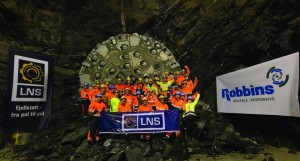
The 7.4 km (4.6 mi) long headrace tunnel for the RøssågaHydroelectric Project offered up a number of challenges to the crew. “We bored through hard, quartz-rich rock with rock strengths up to 300 MPa (43,500 psi) UCS and softer karstic limestone with water ingress,” explained Tobias Andersson, TBM Manager for contractor Leonhard Nilsen & Sønner(LNS). Despite the geological challenges, the TBM performed very well and achieved a record production of 250 m (820 ft) advance in one week, as well as a high of 54 m (177 ft) in one day. Advance rates consistently ranged from 180 to 200 m (590 to 660 ft) per week throughout the project.
The hard and abrasive rock required both fine-tuning of the disc cutters and a learning curve with regards to TBM operation. “We overcame the rock by adapting driving parameters to the different geology, cutter wear and vibrations of the machine. We had regular maintenance, but most important of all we got really good at changing the cutters, with times down to 10 minutes per cutter change, which couldn’t have been done without good team work,” said Andersson.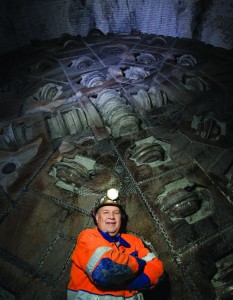
It was the many cutter changes that prompted the close-knit team of LNS and Robbins to look for a better solution. “Extremely hard rock (above 250 MPa/36,300 psi) will always be a great challenge for any cutter. The very special features of the rock encountered combined with the extreme hardness made us go back to the Robbins Cutter Department to develop special cutter rings for the project. These rings increased the cutter life significantly for the project and contributed to the good production,” said Sindre Log, General Manager of Robbins Norway.
The Robbins TBM was launched following Onsite First Time Assembly (OFTA) in January 2014, less than twelve months after contract signing, and was from the outset designed for hard rock conditions. A Measurement While Drilling (MWD) system was included to analyze the ground conditions ahead of the TBM, while probe drilling was done systematically throughout the project. “This is a strong and simple machine ready to tackle hard rock conditions, but also designed to handle softer rock, which allowed for fast excavation. We had good support from competent Robbins field service,” said Andersson.
After all the obstacles, it was clear that the breakthrough ceremony celebrated a triumph of teamwork as well as a new chapter for TBMs in Norway. “Our whole jobsite was gathered for the event: LNS management, representatives from Robbins, and our client Statkraft. People said it was the best breakthrough event they had seen,” said Andersson. Now that tunneling is complete, project owner Statkraft will work to commission the tunnel and fill it with water by spring 2016.
Image 1: The LNS and Robbins crew celebrate Norway’s first TBM breakthrough in 23 years at the RøssågaHydroelectric Project. Photo credit: LNS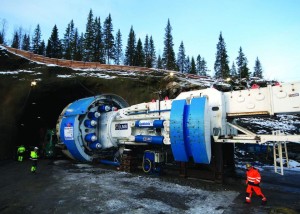
Image 2:Kare Solhaug of Robbins Field Service stands proudly in front of the 7.2 m (23.6 ft) diameter TBM on the day of its breakthrough December 10, 2015. Photo credit: LNS
Image 3:The Robbins Main Beam machine was launched in January 2014 and overcame incredibly hard rock, water inflows, and more. Photo credit: Statkraft
Uncategorized
Jared Griffiths Provides Rock Solid Expertise to Drillers
THOMPSON, CONNECTICUT USA, December 11, 2015– Numa, the leading designer and manufacturer of down hole hammers and bits, has announced the addition of Jared Griffiths as a Field Technician. The addition of Griffiths further expands the field support team that has been synonymous with Numa for the past 30 years.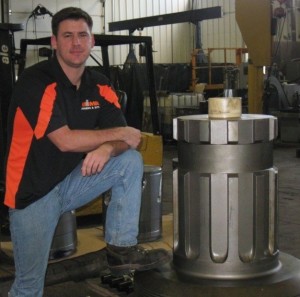
“Numa continues to support our customers both in engineering of superior products and on the job site technical support,” said Numa President Ralph Leonard. “The relationship with our customers is paramount to our success and we are committed to providing expertise in the field where it is needed most. Jared’s addition further reinforces Numa’s dedication to being a trusted partner with our customers on the job site and beyond.”
In this role, Griffiths will support Numa customers on hammer start-ups and on-going technical support. He will advise drillers on best practices for using Numa products including critical insights on drill prep, assembly, air pressure, weight on bit, rotation speed, and drilling techniques to optimize performance. His role also includes consulting and test engineering to determine the most appropriate hammer and bits for ground conditions being encountered on jobs.
Griffiths has worked his way up through Numa’s manufacturing and field operations teams, holding a wide range of roles that has given him an unparalleled depth of understanding of DTH products. In addition to providing field support, Griffiths has previously held positions where he manufactured hammer and bit parts in addition to roles where he was responsible for assembly and repairs. All of Griffiths’ experience provides drillers a critical resource with in-depth knowledge into how Numa products are built, how they operate, and how customers can best maximize performance.
ABOUT NUMA
Numa is the global leader in the design and manufacturing of down hole hammers and bits for drilling vertical, horizontal, and reverse circulation holes from 3½ to 48 inches (89 – 1,219 mm) in diameter. Numa’s products are used in over 105 countries drilling in a wide range of industries including Construction, Foundation, Micro Piling, Oil & Gas, Quarry, Mining, Utility, Geothermal, Environmental, Horizontal, and Water Well.
Foremost to the success of our customers is Numa’s personal service and technological expertise. Numa is dedicated to supporting customers on the job site and is constantly talking to drillers around the world to get first hand input about the products required for today’s demanding drilling environment. Being so close to drillers’ needs has allowed Numa to develop 13 patents for ground breaking drilling technology and produce over 100 different DTH hammer and bit models in a state-of-the-art manufacturing facility.
For more information visit: www.numahammers.com
Uncategorized
Release Date: 12/22/2015
Contact Information: Margot Perez-Sullivan, 415-947-4149, PerezSullivan.Margot@epa.gov
SAN FRANCISCO –The U.S. Environmental Protection Agency announced more than $19 million in funding to Nevada for investments in statewide improvement in local drinking water and wastewater infrastructure and the reduction of water pollution. Nevada’s Clean Water State Revolving Fund (SRF) provides financing for municipal wastewater treatment projects, while the state’s Drinking Water SRF provides financial assistance for drinking water infrastructure improvements.
“This substantial investment at the federal level helps communities develop the infrastructure needed for clean, safe drinking water and proper wastewater treatment,” said Jared Blumenfeld, EPA’s Regional Administrator for the Pacific Southwest. “EPA is committed to protecting the water resources so important to public health and Nevada’s economy.”
Funds provided by the state will go to a variety of water quality infrastructure improvement projects throughout Nevada. Clean Water SRF money goes to projects that benefit public health and the environment, such as converting septic systems to sewer, and that increase reliability and sustainability of wastewater through upgrades and renovations to treatment facilities and sewer lines. Drinking Water SRF money is used to address health risks and improve community and public water systems by supporting projects like groundwater and surface water treatment systems, water storage, transmission and distribution systems, and water metering. For example, the Baker General Improvement District expects to receive over $475,000 to replace a failing water tank with a new 265,000-gallon welded steel tank, which will save thousands of gallons of treated water each year and substantially reduce treatment costs.
Previous Nevada SRF funds have provided $30 million to Clark County Water Reclamation District to upgrade to a more conventional tertiary treatment system. The money has gone to ongoing replacement of old treatment filters, installing additional filters and ultraviolet (UV) disinfection systems. These upgrades increase treatment capacity for used water and sewage and reduce capital and operational costs.
EPA has awarded a combined $205.3 million in federal funding for Nevada’s Clean Water and Drinking Water State Revolving Fund programs since their inception in 1988 and 1996. The funds are used for a wide variety of water quality projects including watershed protection and restoration, water and energy efficiency, wastewater reclamation, and traditional municipal wastewater treatment systems including nonpoint source pollution control. The funds also support drinking water infrastructure, as well as drinking water plant operator training, and technical assistance.
The EPA’s Pacific Southwest Region administers and enforces federal environmental laws in Arizona, California, Hawaii, Nevada, the Pacific Islands and 148 tribal nations—home to more than 48 million people.
For more information on EPA Region 9’s State Revolving Fund program, visit: http://www.epa.gov/region9/water/grants/srf-loan-prog.html
Uncategorized
Release Date: 12/22/2015
Contact Information: Margot Perez-Sullivan, 415-947-4149, PerezSullivan.Margot@epa.gov
SAN FRANCISCO –The U.S. Environmental Protection Agency announced more than $19 million in funding to Nevada for investments in statewide improvement in local drinking water and wastewater infrastructure and the reduction of water pollution. Nevada’s Clean Water State Revolving Fund (SRF) provides financing for municipal wastewater treatment projects, while the state’s Drinking Water SRF provides financial assistance for drinking water infrastructure improvements.
“This substantial investment at the federal level helps communities develop the infrastructure needed for clean, safe drinking water and proper wastewater treatment,” said Jared Blumenfeld, EPA’s Regional Administrator for the Pacific Southwest. “EPA is committed to protecting the water resources so important to public health and Nevada’s economy.”
Funds provided by the state will go to a variety of water quality infrastructure improvement projects throughout Nevada. Clean Water SRF money goes to projects that benefit public health and the environment, such as converting septic systems to sewer, and that increase reliability and sustainability of wastewater through upgrades and renovations to treatment facilities and sewer lines. Drinking Water SRF money is used to address health risks and improve community and public water systems by supporting projects like groundwater and surface water treatment systems, water storage, transmission and distribution systems, and water metering. For example, the Baker General Improvement District expects to receive over $475,000 to replace a failing water tank with a new 265,000-gallon welded steel tank, which will save thousands of gallons of treated water each year and substantially reduce treatment costs.
Previous Nevada SRF funds have provided $30 million to Clark County Water Reclamation District to upgrade to a more conventional tertiary treatment system. The money has gone to ongoing replacement of old treatment filters, installing additional filters and ultraviolet (UV) disinfection systems. These upgrades increase treatment capacity for used water and sewage and reduce capital and operational costs.
EPA has awarded a combined $205.3 million in federal funding for Nevada’s Clean Water and Drinking Water State Revolving Fund programs since their inception in 1988 and 1996. The funds are used for a wide variety of water quality projects including watershed protection and restoration, water and energy efficiency, wastewater reclamation, and traditional municipal wastewater treatment systems including nonpoint source pollution control. The funds also support drinking water infrastructure, as well as drinking water plant operator training, and technical assistance.
The EPA’s Pacific Southwest Region administers and enforces federal environmental laws in Arizona, California, Hawaii, Nevada, the Pacific Islands and 148 tribal nations—home to more than 48 million people.
For more information on EPA Region 9’s State Revolving Fund program, visit: http://www.epa.gov/region9/water/grants/srf-loan-prog.html
Uncategorized
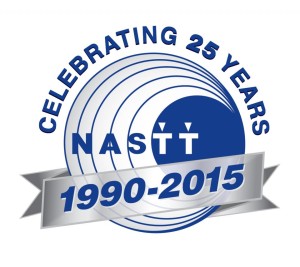 NASTT turns 25 in 2015! What was happening 25 years ago?
NASTT turns 25 in 2015! What was happening 25 years ago?
On Christmas Day, 1990, “The Godfather Part III” directed by Francis Ford Coppola and starring Al Pacino, Diane Keaton and Andy Garcia premiered.
Also on Christmas Day, 1990, the first successful trial run of the system which would become the World Wide Web occurred.
And on December 31, 1990, the Sci-Fi Channel on cable TV began transmitting.
And that’s a wrap! We had a great time looking back at the last 25 years this year. We hope you enjoyed it too!






